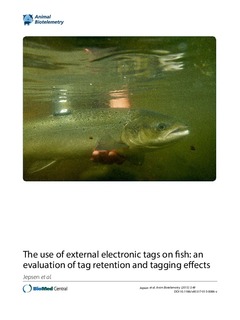| dc.description.abstract | External tagging of fish with electronic tags has been used for decades for a wide range of marine and freshwater
species. In the early years of fish telemetry research, it was the most commonly used attachment method, but later
internal implants became preferred. Recently, the number of telemetry studies using external tagging has increased,
especially with the development of archival tags (data storage tags, DSTs), pop-up satellite archival tags (PSATs) and
other environment-sensing tags. Scientific evaluations of the tagging method are rather scarce for most species. We
identified 89 publications, reporting effects of external tagging for 80 different fish species, which constitute the main
basis for this review. External attachment holds certain benefits compared to other tagging methods, for example,
speed of application, and it may be the only option for fishes with a body shape unsuitable for surgical implantation,
or when using tags with sensors recording the external environment. The most commonly reported problems with
external tags are tissue damage, premature tag loss, and decreased swimming capacity, but the effects are highly
context dependent and species specific. Reduced growth and survival have also been recorded, but direct mortality
caused by external tagging seems rare. Most of the studies reviewed evaluate tag retention, survival, and tissue reactions.
There is a general need for more research on the effects of external tagging of fish with electronic tags, but particularly
there are few studies on predation risk, social interactions, and studies distinguishing capture and handling
effects from tagging effects. For PSATs, especially those that are large relative to fish size, there are particular problems
with a high proportion of premature tag losses, reduced swimming capacity, and likely increased predation, but
there remains a paucity of tag effect studies related to the use of PSATs. Before embarking on a field study employing
external tagging with electronic tags, we recommend the use of appropriate pilot studies, controlled where possible,
to quantify potential impacts of tagging.
Telemetry, Tag attachment, Archival tag, PSAT, Survival, Tissue damage, Tag retention, Growth, Swimming,
Drag, Entanglement, Biofouling, Predation | nb_NO |

